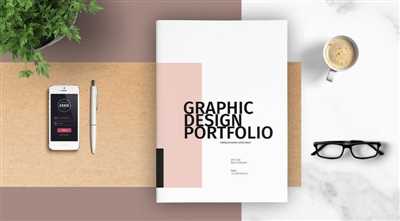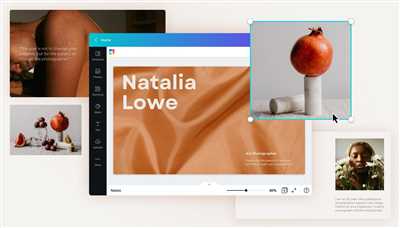
Creating a portfolio is an essential step for any designer or creative professional. A well-curated portfolio showcases your skills, creativity, and experience to potential clients or employers. Whether you’re a graphic designer, web developer, or any other type of creative, having a portfolio is crucial in demonstrating your expertise and landing new opportunities. In this article, we’ll show you how to put together a portfolio that will impress and inspire.
When putting together your portfolio, it’s important to focus on your core message and the type of work you want to showcase. Think about your target audience and what kind of projects or clients you want to attract. For example, if you’re a graphic designer specializing in branding and logos, your portfolio should highlight your expertise in that area. By narrowing your focus, you can create a portfolio that tells a cohesive story and speaks directly to your target audience.
One of the first steps in creating a portfolio is gathering samples of your work. Look through your past projects and select the ones that best represent your skills and style. If you’re just starting out and don’t have any professional work to showcase, you can create mock projects or personal projects to include in your portfolio. The key is to have a variety of samples that demonstrate your range and abilities as a designer.
When assembling your portfolio, consider the visual and informational elements that will make it stand out. Use high-quality images and visually appealing layouts to showcase your work. Include descriptions or captions that provide context and explain your thought process behind each project. If you have any notable achievements or awards, make sure to highlight them as well. The goal is to provide enough information for viewers to understand and appreciate your work, but not to overwhelm them with too much text.
In addition to your design samples, you may also want to include a section that showcases your writing skills. Many designers are now expected to have basic writing abilities, especially in the age of social media. Including some blog posts, articles, or even samples of social media posts can demonstrate your ability to communicate and engage with an audience. This can be particularly helpful for designers who are interested in working with brands or clients who value content creation and social media presence.
Lastly, don’t be afraid to get inspired by other designers and portfolios. Look at industry-leading designers and see how they present their work. Take note of the colors, layouts, and overall design of their portfolios. While you should always stay true to your own style and brand, getting inspired by others can help you strategize and improve your own portfolio. Just remember to not copy directly from others, but rather, use their work as a jumping-off point to find your own unique voice.
In conclusion, putting together a portfolio is an important step for any designer or creative professional. By following these tips and steps, you can create a portfolio that showcases your skills, tells a compelling story, and attracts the right kind of attention. Remember to stay focused on your core message, select the best samples of your work, and present it in a visually appealing and informative way. Your portfolio is your chance to make a strong first impression, so take the time to polish and refine it before sharing it with the world.
Portfolio 101: How to Put Together a Portfolio

When it comes to creating a portfolio, there are a few key things to keep in mind. The first is to determine your focus. What industry or field do you want to target? Once you have that figured out, you can start strategizing on what kind of work samples you should include.
It’s important to seek inspiration from other portfolios and designers in your industry. Look at their work and see what you like and what you would do differently. This can help you get a better idea of how to design your own portfolio.
Next, writing a clear and concise message is crucial. You want potential employers or clients to understand what you do and what your style is. Keep your text short and to the point, but make sure it provides enough information to showcase your skills and talents.
Visual appeal is also important, as it can help your portfolio stand out. Use colors and design elements that reflect your style and personality. Consider using different media, such as videos or interactive elements, to add depth and interest to your portfolio.
When it comes to organizing your portfolio, you want to make it easy for others to navigate. Use clear headings and sections to break up your work samples, and consider adding descriptions or notes to provide context for each piece.
As you’re putting your portfolio together, don’t forget to keep an eye on the future. Make sure to include any projects or samples that highlight your potential and show what you’re capable of.
If you’re having trouble coming up with ideas, consider taking on some charity work or pro bono projects. Not only does this give you the opportunity to help others, but it also gives you more work to showcase in your portfolio.
One thing to keep in mind is that your portfolio doesn’t have to be set in stone. You can always update and add to it as you go along. As you gain more experience and work on new projects, you can swap out old samples for newer ones.
If you’re not a designer yourself, don’t be afraid to seek help. There are plenty of resources available, such as graphic designers or portfolio-building websites, that can assist you in creating a visually appealing and professional portfolio.
Lastly, make sure to keep your portfolio up to date. Add new projects as soon as you complete them, and remove any outdated or irrelevant work. You want your portfolio to showcase your most recent and relevant accomplishments.
In conclusion, putting together a portfolio is a crucial step for any designer or creative professional. By following these tips and considering the things mentioned above, you can create a portfolio that showcases your skills and impresses potential clients or employers. So jump on, start designing, and put together a portfolio that will inspire others!
Strategize first, write second, design last
When it comes to putting together your portfolio, strategizing should always be the first step. Before you even start writing or designing, take some time to think about your goals, target audience, and what message you want your portfolio to convey. This will help you focus on what samples to include and how to present them.
For example, if you’re in the graphic design industry, you might want to put together a portfolio that showcases your skills in creating visually appealing designs. In this case, you would focus on selecting your best graphic design work and organizing it in a visually pleasing way.
When writing about your work, it’s important to keep in mind that your audience may not be familiar with your industry jargon. Make sure to explain any technical terms or industry-specific information in a way that everyone can understand. Think about how a person outside of your industry would benefit from seeing your work.
After you’ve strategized and written about your work, it’s finally time to think about the design. The visual layout and design of your portfolio should complement the content and enhance the overall message you want to convey. Consider the colors, typography, and overall aesthetics that will best represent your style and brand.
Remember, creating a portfolio is an ongoing process. Even if you have limited work experience or are just starting out, you can still put together a portfolio that shows your potential. Seek inspiration from other designers, follow industry news and trends, and don’t be afraid to ask for help or feedback from others.
One great tip is to take notes whenever you see a portfolio that inspires you. Write down what you like about it, what makes it stand out, and how you can apply those elements to your own portfolio. These notes can serve as a guide for later when you’re designing.
Lastly, don’t forget that your portfolio is a reflection of yourself as a designer. It should show your unique style, skills, and personality. So, don’t be afraid to let your creativity shine and make sure that every design decision you make is intentional and supports your core message.
In conclusion, when putting together your portfolio, remember to strategize first, write about your work second, and design last. By following these steps, you’ll be able to create a portfolio that effectively showcases your talents and leaves a lasting impression on potential clients or employers.
Sign up to our newsletters

If you’re a designer or someone seeking inspiration in the industry, our newsletters can help you stay informed and get the tips and tricks you need to take your work to the next level.
When it comes to creating a portfolio, designers often struggle with how to put it all together. Our newsletters provide step-by-step guides, industry 101, and core design principles to help you strategize and focus on what’s most important.
Whether you specialize in graphic design, web design, or any other visual medium, our newsletters include samples, case studies, and portfolio showcases to inspire your own work. We also provide writing tips and examples to help you craft compelling portfolio descriptions and explain your design process.
By signing up to our newsletters, you’ll also gain access to exclusive house workshops and limited time design challenges. These are great opportunities to jump-start your own design projects and get feedback from industry professionals.
If you’re interested in the social and ethical aspects of design, our newsletters also cover topics like designing for charity or creating positive impact through your work. We provide resources and case studies that show how designers can use their skills for good.
To sign up, simply enter your name, email address, and phone numbers in the form below. Once registered, you’ll start receiving our newsletters with all the latest design news, trends, and insights. Don’t miss out on the opportunity to stay inspired and connected with the design community.
Get inspired, get informed, and get ahead in the industry by signing up for our newsletters today!
———————————-
For more information, follow us on social media:
Instagram: @design101
Twitter: @designersunited
Facebook: /designinspired
———————————-
For those who would like to seek more personalized help, we also offer design consultations and portfolio reviews. Reach out to us at [email protected] or give us a call at +1 123 456 7890.
Design101 Ltd.
123 ABC Street,
London EC3N 1AS,
United Kingdom
Follow us on social media
When it comes to creating your portfolio, it’s important to showcase your work on social media platforms. Social media is a powerful tool that can help you get yourself and your work out there to a wider audience. It’s a platform where you can share your portfolio, engage with your audience, and gain valuable feedback and inspiration from other designers.
Here are some tips to help you strategize your social media presence:
- Focus on the core platforms: There are numerous social media platforms available, but it’s important to focus your efforts on the ones that are most relevant to your industry. For graphic designers, platforms like Instagram and Behance are some of the most popular choices.
- Sign up and register: If you haven’t already, create accounts on these platforms and register yourself as a designer. This will help you establish your identity and provide a professional touch to your online presence.
- Follow and engage: Start following other designers, industry influencers, and creative accounts. Engage with their work by liking, commenting, and sharing. This will help you build connections and get noticed within the design community.
- Share your work: Regularly post samples of your work on your social media accounts. Use high-quality images or videos to showcase your designs in the best possible way. Be sure to provide some context or insight into your design process, inspiration, or the problem your design solves.
- Keep your portfolio up-to-date: Your social media profiles should provide a glimpse into your portfolio. Make sure your latest and best work is showcased prominently. If you’re limited by the number of pieces you can share, consider rotating them periodically to keep your feeds fresh.
- Join design communities: Participate in design challenges, games, or competitions on social media. This will not only help you improve your skills but also allow you to network and connect with other designers.
- Seek inspiration: Follow accounts that inspire you and keep up with the latest design trends and news. This will help you stay informed and motivated to create better designs.
- Use social media tools: Social media tools can help you schedule posts, track engagement, and manage your social media presence more efficiently. Explore different tools and utilize those that work best for you.
- Create newsletters: Consider creating newsletters to keep your audience updated on your latest work, design tips, and industry insights. Encourage your audience to sign up for these newsletters to stay connected with your work.
- Don’t forget about your website: Your social media profiles should complement your portfolio website. Make sure to include links to your website in your social media bio or posts. Your website should have a design that aligns with your social media profiles, as it serves as your virtual house to showcase your best work.
Remember, social media is not just about self-promotion. It’s about building relationships, getting inspired, and staying connected with the design community. So, jump in and start engaging yourself in the wonderful world of social media!
Get Inspired
When it comes to putting together your portfolio, the first thing you should do is get inspired. Taking a look at other designers’ portfolios can give you a great starting point and help you gather ideas for your own. Whether you jump on social media or seek out portfolios of registered graphic designers, you’re sure to find plenty of examples to inspire you.
One way to get inspired is to focus on the visual aspects of a portfolio. Pay attention to the colors, layout, and overall design. Note what works well and what grabs your attention. You can also seek inspiration in other industries, such as architecture or fashion. Look at how they showcase their work and convey their message.
Another great way to get inspired is by reading industry news and newsletters. These can provide insights into the latest trends and give you ideas for how to present your portfolio. You might also find examples of successful portfolios that you can learn from.
Don’t limit yourself to just graphic design portfolios. Take a look at portfolios in other creative fields as well. You may find inspiration in the way photographers, writers, or game designers showcase their work.
After gathering inspiration, the next step is to strategize. Think about what you want your portfolio to achieve and what message you want to convey. Consider your target audience and tailor your portfolio accordingly. Remember, your portfolio is a reflection of you and your work, so make sure it represents you well.
When it comes to creating your portfolio, there are a few tips to keep in mind. Firstly, keep it focused. Highlight your best work and include relevant information, but don’t overwhelm your audience with too much content. Second, make it easy to navigate. Use clear categories and labels to help visitors find what they’re looking for. And lastly, make sure your portfolio is mobile-friendly. With more and more people using their phones to browse the web, you want to ensure your portfolio looks great on all devices.
|
| For example, if you’re a graphic designer, you might include samples of your work showcasing different styles and techniques. You could also include some writing samples or newsletters you’ve designed. If you’ve worked on any social media campaigns or charity projects, be sure to showcase those as well. The key is to show potential clients what you can do and how you can help them. |
So, get inspired, take notes, and start putting together your portfolio. Remember, it’s a representation of you and your work, so make sure it’s the best it can be. And don’t worry if you’re not a designer yourself. You can always seek help from a professional to create a portfolio that truly stands out.










